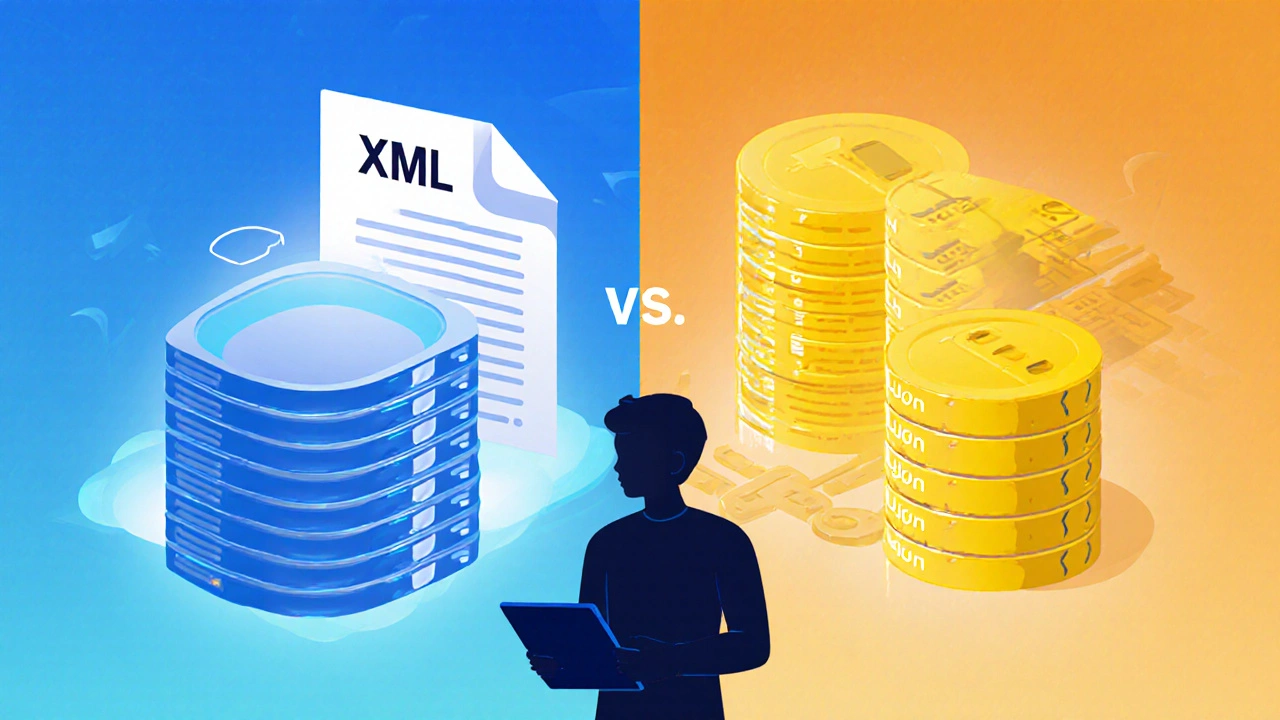Is XML Front‑End or Backend? Understanding Where XML Belongs
XML vs JSON Comparison Tool
XML
Extensible Markup Language - used for data interchange and configuration.
JSON
JavaScript Object Notation - lightweight data interchange format.
Compare Key Aspects
| Aspect | XML | JSON |
|---|---|---|
| Verbosity | Higher - requires opening and closing tags for each element | Lower - uses key-value pairs without extra tags |
| Schema Support | Strong - supports XSD, DTD, RELAX NG | Weak - JSON Schema exists but less mature |
| Human Readability | Good for complex hierarchies | Easy for simple data structures |
| Parsing Speed | Slower, especially with DOM parser | Fast, native in JavaScript |
| Industry Adoption | Legacy systems, finance, publishing | Web APIs, mobile apps |
When to Use Which
Use XML When:
- You need strict validation
- Working with legacy SOAP services
- Interoperating with industry standards (HL7, XBRL)
- Need namespaces to avoid tag collisions
- Working with configuration files (web.xml, app.config)
Use JSON When:
- Building modern web APIs
- Working with JavaScript-heavy frontends
- Performance is critical
- Simple data structures are sufficient
- Developing mobile apps or RESTful services
Quick Decision Guide
Recommendation
When developers ask, “Is XML front‑end or backend?” they’re really trying to pin down where this markup language fits in modern web stacks. XML is a text‑based, hierarchical format designed for storing and transporting structured data. It isn’t a UI framework like HTML, nor is it a server‑side language like PHP. Instead, XML sits in the middle, acting as a bridge between front‑end interfaces and back‑end systems.
Quick Takeaways
- XML is a data‑interchange format, not a UI technology.
- It can appear on both front‑end (e.g., SVG, XHTML) and back‑end (e.g., config files, API payloads).
- Modern apps often favor JSON, but XML remains crucial for legacy systems, SOAP services, and certain industry standards.
- Choosing XML vs. JSON depends on ecosystem, schema needs, and tooling.
- Understanding XML’s role helps you design cleaner architectures.
What XML Actually Is
At its core, XML (eXtensible Markup Language) lets you define custom tags to describe data. Its key attributes are:
- Self‑describing: Each element carries meaning, making files readable by humans and machines.
- Validated by schemas: XSD or DTD files enforce structure, ensuring data consistency.
- Unicode support: Handles any language, crucial for international applications.
This definition makes XML a natural choice for configuration files, document storage, and protocol messages.
Front‑End Encounters with XML
While XML isn’t a visual language, several front‑end technologies are XML‑based:
- SVG (Scalable Vector Graphics) uses XML syntax to describe graphics directly in the browser.
- XHTML (Extensible HTML) is basically HTML written as well‑formed XML.
- Web browsers can parse and render RSS (Rich Site Summary feeds) and Atom (web syndication format), both XML documents.
In these cases, XML lives right in the front‑end, but it’s still just data - the browser’s rendering engine turns it into visuals.

Back‑End Uses of XML
On the server side, XML shines in scenarios where strict validation and extensibility matter:
- SOAP (Simple Object Access Protocol) wraps requests and responses in XML envelopes, providing a formal contract via WSDL.
- Enterprise configuration files - think web.xml (Java servlet descriptor) or .NET app.config.
- Data export/import pipelines, especially in finance, health, and publishing, where industry standards (e.g., HL7, XBRL) mandate XML.
- Document storage: Office Open XML (DOCX, XLSX) bundles XML parts inside a zip archive.
Back‑end code usually reads XML with parsers like DOM, SAX, or StAX, then maps it to objects for business logic.
XML vs. JSON: When to Pick One
| Aspect | XML | JSON |
|---|---|---|
| Verbosity | Higher - tags for every element | Lower - key/value pairs |
| Schema support | Strong - XSD, DTD, RELAX NG | Weak - JSON Schema exists but less mature |
| Human readability | Good for complex hierarchies | Easy for simple data structures |
| Parsing speed | Slower, especially with DOM | Fast, native in JavaScript |
| Industry adoption | Legacy systems, finance, publishing | Web APIs, mobile apps |
If you need strict validation, namespaces, or to interoperate with older SOAP services, XML remains the go‑to choice. For lightweight, browser‑centric APIs, JSON wins.
Practical Tips for Working with XML
- Pick the right parser: use DOM when you need random access, SAX for large streams, or StAX for a balance.
- Always validate against an XSD if the data comes from an external source.
- Leverage namespaces to avoid tag collisions, especially when merging multiple XML vocabularies.
- Consider transforming XML with XSLT when you need to produce HTML or another XML format.
- Cache parsed results when possible - parsing can be a bottleneck.
TL;DR (Quick Checklist)
- XML is a data format, not a UI layer.
- It appears on the front‑end only in XML‑based markup languages (SVG, XHTML, RSS).
- Back‑end uses include SOAP, configuration files, and industry‑standard documents.
- Choose XML when you need strong schema enforcement or need to interact with legacy services.
- For new web APIs, JSON is usually faster and easier.

Frequently Asked Questions
Can I use XML directly in a modern JavaScript front‑end?
Yes, browsers provide DOMParser to turn XML strings into DOM objects. However, you’ll often convert XML to JSON first, because JavaScript handles JSON natively.
Is XML still relevant in 2025?
Absolutely. Industries like finance, healthcare, and publishing still rely on XML standards (e.g., XBRL, HL7). New projects that need strict validation or namespace support also favor XML.
What’s the biggest performance drawback of XML?
Parsing XML is more CPU‑intensive than JSON, especially when using a DOM parser that builds an entire tree in memory. Large payloads can cause latency on low‑power devices.
When should I prefer SOAP over REST?
Choose SOAP when you need formal contracts, WS‑Security, or transactional guarantees that are baked into the protocol. For simple CRUD operations, REST with JSON is lighter.
How do I validate an XML file against an XSD?
In Java, use javax.xml.validation.SchemaFactory. In Python, lxml.etree.XMLSchema does the job. Most languages provide a built‑in validator you can call from command line.





